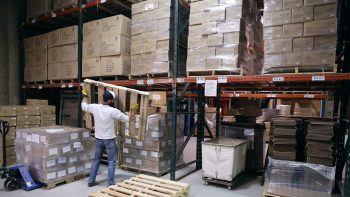
With shipping costs sky-high, is importing products even worth it?
With shipping costs sky-high, is importing products even worth it?

Supply chain congestion is having a big impact on the prices consumers are paying throughout the economy. But the stores that sell imported products have to pay higher prices for imports too, and with shipping costs rising, a lot of businesses are wondering whether imports are even worth it right now.
Palmetto Tile Distributors in South Carolina sells porcelain tile from Spain and Italy — and all of that tile has to pass through the global supply chain.
“It’s been a little bit of a stressful year,” said Cathrine Reynolds, who handles imports at Palmetto.
Reynolds said manufacturing is taking longer. Then, it can take weeks to find a shipping container, let alone a ship with enough space to carry it. Once the tile actually makes it to the U.S., Reynolds said, it can take four weeks for the vessel to dock at the port to be unloaded.
“And then once we get into the port to be unloaded, they’re completely overwhelmed,” Reynolds said.
That’s when the cost of shipping starts to really ramp up. Reynolds said she’s paying port congestion fees and peak-season fees. She’s also paying to store goods in warehouses while she waits for available trucks. Door-to-door shipping costs for imported tile used to be around $5,000 to $6,000 per container, she said. Now, they’re around $12,000 to $13,000.
As a result, Reynolds is cutting back on a lot of products she’d like to import.
“In particular, a couple of tiles I want to bring in because I know they’ll be phenomenal sellers for our market. I know we’ll do well,” Reynolds said. “But I’ve hesitated. I’m not bringing them in right now because the cost of the particular product is fantastic to import. But the cost of importing, I can’t justify it.”
There is theory behind when businesses can justify importing goods, said Dale Rogers, professor of supply chain management at Arizona State University.
“Typically, you don’t want the cost of shipping, really total logistics costs, to be above 10% of the value of the product,” Rogers said.
Bigger importers, like big box stores, can control those costs through scale. Some have even chartered their own ships to bring those costs down.
“A small supplier, a small importer, can’t afford to do that,” Rogers said. “And they don’t have a lot of choices.”
The choices that importers have also depend on the kind of products involved, said Chris Duong, general manager of Hawaii Supermarket in Los Angeles.
For instance, Duong said he’s had to raise prices on staples, like bags of Thai jasmine rice, by around $10 to $20 for a 50-pound bag.
“Rice is one of those things you have to have, regardless of the price,” he said.
Hawaii Supermarket also sells imported alcohol, like French wine and cognac. People who want those items can probably afford to pay the higher prices, Duong added.
“If they’re used to spending $40 to $50 on a bottle of alcohol, a $10 increase might not be such a big deal to them,” he said.
But there are some products he can’t raise prices on by enough to cover the increased cost of shipping. Those include cheaper products like cream crackers or bags of coffee candy, which probably won’t sell if prices rise.
“People aren’t going to have money in their budget to buy that extra bag of chips or chocolate or candy that they might have if the cost of rice wasn’t $10 more a bag,” he said.”
Duong simply isn’t stocking those items anymore. Throughout the store, he’s spreading out the products he does have to fill the gaps.
“We make do with what we have, and make lemonade out of lemons,” he said. “That’s our job, to make the store look good and look stocked.”
Duong said Hawaii Supermarket prides itself on the variety of goods it sells. But right now, he considers himself pretty lucky that he has any products to sell at all.
There’s a lot happening in the world. Through it all, Marketplace is here for you.
You rely on Marketplace to break down the world’s events and tell you how it affects you in a fact-based, approachable way. We rely on your financial support to keep making that possible.
Your donation today powers the independent journalism that you rely on. For just $5/month, you can help sustain Marketplace so we can keep reporting on the things that matter to you.


















